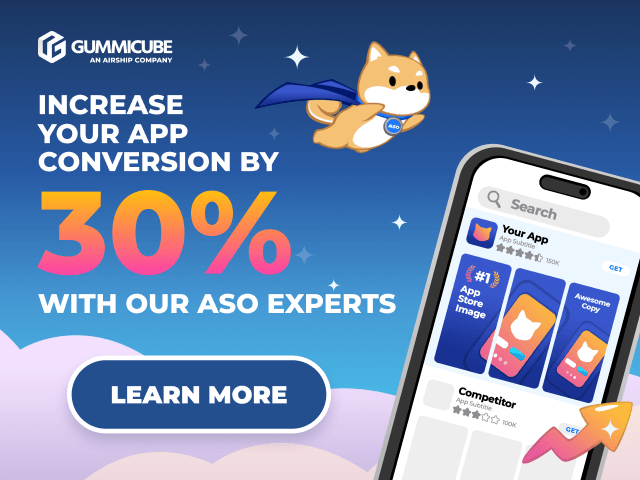In the fiercely competitive landscape of app marketing, achieving visibility inside the app stores is a holy grail for app developers. App Store Optimization (ASO) is the key to this success, but what are the factors that actually matter when successfully optimizing a mobile app? Many people have differing opinions, but after working with thousands of apps we have some clear answers. Let’s dissect these elements and understand why they are equally essential for a thriving app presence.
Elements of ASO and their importance
The core ASO factors are like pieces of a puzzle — Visible Metadata, Hidden Metadata, Creatives, Paid Campaigns, Crash Rates, Reviews, and Retention. There is a great deal of discussion around which of these components has greater “weight” and this question can produce incredibly misleading and inaccurate responses. The reality that may surprise many is that these factors hold equal weight in shaping an app’s destiny.
How can this be? It’s simple. Every app has a unique set of strengths and weaknesses, target audiences, and of course, is engineered by different groups of developers. No two apps are truly the same. The factors that impact ASO are pulled on from different sides – like a game of tug of war – making the most “important factor” potentially different for each app. As an example, an app that has an average five-star rating but a high crash rate might rank lower than an app with a four-star rating but a better user experience.
At a certain point, positive movement in one area is offset by a negative in another, requiring a holistic “focus on it all” approach to really win. Emphasis on just one area because a tipster says it is weighted more heavily than another makes absolutely no sense from a medium to long-term perspective.
ASO factors: A Breakdown
Visible Metadata (Title, Subtitle, Description): The first impression matters, which is why crafting compelling and keyword-rich visible metadata is crucial. Visible metadata gives users a chance to understand your app and its benefits at a glance. More importantly for Google, these three fields are indexed, directly impacting your keyword rankings.
Hidden Metadata (Keywords): Non-visible assets such as your keyword bank structurally inform the Apple algorithm of which terms you’re prioritizing and looking to rank for, ultimately branching out your reach across hundreds or thousands of keywords.
Creatives (Icon, Screenshots, In-App Event/Promotional Content, Videos): Emphasize priority features related to core keyword targets in creatives to enhance relevance and boost conversion potential.
Paid Campaigns (Apple Search Ads, Google Ads, Social Campaigns, Programmatic): Incorporate a strategic mix of paid campaigns that complement organic efforts to maximize visibility and conversions.
Crash + Freezing Rates: App performance is a silent but critical player. High crash rates and ANR rates can diminish store placement potential.
Reviews: User ratings and reviews directly impact conversion potential. Maintaining a high star rating is crucial to maintaining and increasing conversion rates.
Retention: Sustaining user interest and engagement is key to long-term success.
Weight: Do not ask which factor is more important – it is the wrong question. Unlike a one-size-fits-all approach, the significance of each ASO component can shift based on app performance. Our approach is holistic, where proper attention and strategies are tailored towards areas that make the most impact given the app’s standing across any factor.
The increased importance will ultimately depend on an app’s existing performance, areas of improvement, and objectives moving forward. For example, a gaming app might prioritize creatives to showcase engaging visuals, while a utility app might emphasize metadata for clear communication of its features.
Understanding the factors affecting app store performance can help you measure the impact of your ASO later on. Read more here.
How to address the factors of ASO
Ensuring relevance for targeted keywords is paramount for long-term success as the stores won’t favor apps that are irrelevant in search results. A meditation app targeting “stress relief” needs to verify its content aligns with this keyword, offering guided sessions or related calming features.
Targeting important terms in metadata provides the foundation for effective indexing on both the Apple App Store and Google Play. A language learning app must strategically use metadata to target terms like “language learning” to ensure it reaches the right audience.
Testing creatives that focus on the keyword also enhances relevance and boosts conversion potential. A fitness app targeting “home workouts” should highlight this in its creatives, showcasing home exercise routines and fitness benefits.
Supplementing organic with paid search through platforms like Apple Search Ads and Google Ads reinforces and scales organic efforts. A finance app can drive Apple Search Ads for keywords like “budgeting” to amplify visibility and attract users actively searching for financial management solutions.
Maximizing share of voice for key terms by increasing paid placement outshines competitors, resulting in more conversion potential. A travel app competing for “local experiences” can strategically increase paid placement to stand out from rival apps vying for the same audience.
Creating custom listings for ad placements tailors the focus towards maximizing conversion potential on a specific concept. A recipe app can use a Custom Product Page (CPP) to spotlight its unique selling point, such as a vast collection of quick and easy recipes.
App performance, indicated by crash rates, ANR rates, ratings, and star ratings, directly impacts placement potential and user conversion. An e-commerce app with frequent crashes and a low star rating risks losing potential customers who seek a reliable shopping experience.
Overlooking app marketing steps and results
Each of the above ASO factors must be addressed. Overlooking steps, such as neglecting marketing before targeting specific terms or ignoring app quality indicators, can impact results. Launching an app marketing campaign without addressing app performance issues might attract users who then encounter a subpar experience, leading to negative reviews and reduced conversion rates.
Additional ASO considerations
Assuming that everything mentioned above is being managed, additional factors like category relevance, publisher name, and review content can provide a slight edge.
Positive reviews mentioning specific features can reinforce the app’s credibility and potentially attract users searching for those functionalities.
External factors such as volume of external marketing, editorial featuring, competitor initiatives, virality, and seasonality also influence ranking. An app experiencing a surge in external marketing or gaining editorial features might witness a temporary boost in visibility.
In the intricate dance of mobile marketing, without ASO you’re going to step on a lot of toes (and miss a lot of opportunities along the way). Understanding the equal importance of each ASO factor and following this checklist is the key to unlocking app store success. By embracing these considerations and adapting strategies based on app performance, businesses can confidently navigate the dynamic world of app visibility and maximize their potential for sustained success.
Click here to learn more about the factors that affect App Store Optimization and how you can refine your own ASO strategy.











